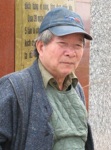Copyright © 1986-2016, Witness Collection and other copyright holders. All rights reserved.
Images and content on this site may not be reproduced in any form without prior written consent from Witness Collection.
For information about exhibitions, loans, internships or other forms of collaboration, please email us via the contact us page.

After joining the Việt Minh resistance army in 1950, Tâm’s artistic and reporting skills were soon put to use when he was assigned to work for Quyết Thắng (‘Be Determined to Win’) newspaper. In his wartime writing and art works, he generally used the nom de plume Huỳnh Biếc to hide his real identity.
Following artillery training in China in 1952-53, Tâm participated in the Điện Biên Phủ campaign as a journalist and artist, living on the front lines and witnessing the hardships and daily life of soldiers and civilian volunteers. His diary and many of his images from Điện Biên Phủ have become known around the world, translated into English and French and published internationally.
In 1963, Tâm began official studies at Vietnam Fine Art College, graduating in 1967 after specialising in oil painting. Due to the escalating conflict with the United States, Tâm volunteered to join the front in the south and was present at Khe Sanh in 1968 during the famous battle, documenting it in his art works. He also witnessed sea action in Hạ Long Bay and was present in Hanoi during the intense 1972 Christmas bombings. Returning to the south via the Hồ Chí Minh trail, Tâm was with North Vietnamese army units when they overran Đà Nắng and Saigon, ending the war in April 1975.
After the war, Tâm collaborated with the Army’s official newspaper, Quân Đội Nhân Dân (‘People’s Army’), to stage many exhibitions of wartime art works. He was subsequently appointed director of the Army’s Art Workshop. In 1989, he retired and moved to Ho Chi Minh City.
Phạm Thanh Tâm
